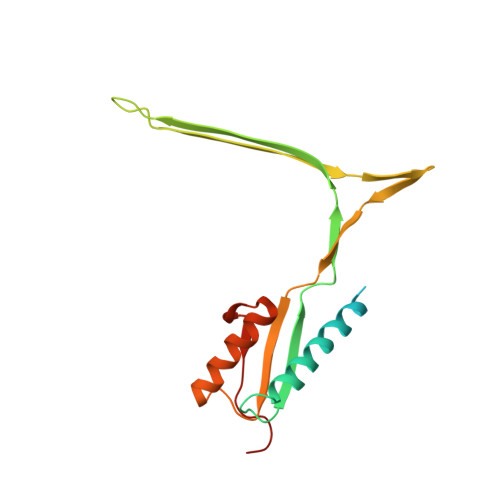Near-atomic resolution cryoelectron microscopy structure of the 30-fold homooligomeric SpoIIIAG channel essential to spore formation in Bacillus subtilis.
Zeytuni, N., Hong, C., Flanagan, K.A., Worrall, L.J., Theiltges, K.A., Vuckovic, M., Huang, R.K., Massoni, S.C., Camp, A.H., Yu, Z., Strynadka, N.C.(2017) Proc Natl Acad Sci U S A 114: E7073-E7081
- PubMed: 28784753
- DOI: https://doi.org/10.1073/pnas.1704310114
- Primary Citation of Related Structures:
5WC3 - PubMed Abstract:
Bacterial sporulation allows starving cells to differentiate into metabolically dormant spores that can survive extreme conditions. Following asymmetric division, the mother cell engulfs the forespore, surrounding it with two bilayer membranes. During the engulfment process, an essential channel, the so-called feeding tube apparatus, is thought to cross both membranes to create a direct conduit between the mother cell and the forespore. At least nine proteins are required to create this channel, including SpoIIQ and SpoIIIAA-AH. Here, we present the near-atomic resolution structure of one of these proteins, SpoIIIAG, determined by single-particle cryo-EM. A 3D reconstruction revealed that SpoIIIAG assembles into a large and stable 30-fold symmetric complex with a unique mushroom-like architecture. The complex is collectively composed of three distinctive circular structures: a 60-stranded vertical β-barrel that forms a large inner channel encircled by two concentric rings, one β-mediated and the other formed by repeats of a ring-building motif (RBM) common to the architecture of various dual membrane secretion systems of distinct function. Our near-atomic resolution structure clearly shows that SpoIIIAG exhibits a unique and dramatic adaptation of the RBM fold with a unique β-triangle insertion that assembles into the prominent channel, the dimensions of which suggest the potential passage of large macromolecules between the mother cell and forespore during the feeding process. Indeed, mutation of residues located at key interfaces between monomers of this RBM resulted in severe defects both in vivo and in vitro, providing additional support for this unprecedented structure.
Organizational Affiliation:
Department of Biochemistry and Molecular Biology and the Center for Blood Research, University of British Columbia, Vancouver, BC, Canada V6T1Z4.














